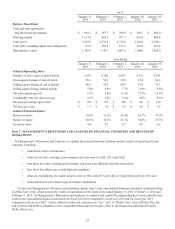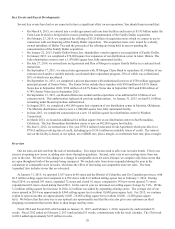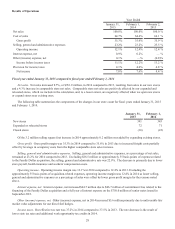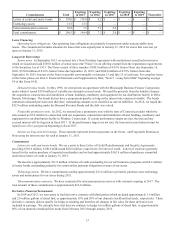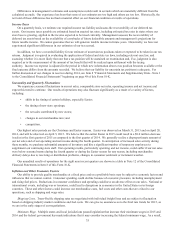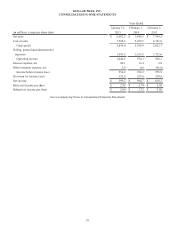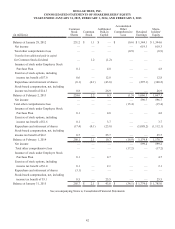Dollar Tree 2014 Annual Report Download - page 50
Download and view the complete annual report
Please find page 50 of the 2014 Dollar Tree annual report below. You can navigate through the pages in the report by either clicking on the pages listed below, or by using the keyword search tool below to find specific information within the annual report.34
Critical Accounting Policies
The preparation of financial statements requires the use of estimates. Certain of our estimates require a high level of
judgment and have the potential to have a material effect on the financial statements if actual results vary significantly from
those estimates. Following is a discussion of the estimates that we consider critical.
Inventory Valuation
As discussed in Item 8. Financial Statements and Supplementary Data, "Note 1 - Summary of Significant Account
Policies" under the caption "Merchandise Inventories" beginning on page 44 of this Form 10-K, inventories at the distribution
centers are stated at the lower of cost or market with cost determined on a weighted-average basis. Cost is assigned to store
inventories using the retail inventory method on a weighted-average basis. Under the retail inventory method, the valuation of
inventories at cost and the resulting gross margins are computed by applying a calculated cost-to-retail ratio to the retail value
of inventories. The retail inventory method is an averaging method that is widely used in the retail industry and results in
valuing inventories at lower of cost or market when markdowns are taken as a reduction of the retail value of inventories on a
timely basis.
Inventory valuation methods require certain significant management estimates and judgments, including estimates of
future merchandise markdowns and shrink, which significantly affect the ending inventory valuation at cost as well as the
resulting gross margins. The averaging required in applying the retail inventory method and the estimates of shrink and
markdowns could, under certain circumstances, result in costs not being recorded in the proper period.
We estimate our markdown reserve based on the consideration of a variety of factors, including, but not limited to,
quantities of slow moving or seasonal, carryover merchandise on hand, historical markdown statistics and future merchandising
plans. The accuracy of our estimates can be affected by many factors, some of which are outside of our control, including
changes in economic conditions and consumer buying trends. Historically, we have not experienced significant differences in
our estimated reserve for markdowns compared with actual results.
Our accrual for shrink is based on the actual, historical shrink results of our most recent physical inventories adjusted, if
necessary, for current economic conditions and business trends. These estimates are compared to actual results as physical
inventory counts are taken and reconciled to the general ledger. Our physical inventory counts are generally taken between
January and September of each year; therefore, the shrink accrual recorded at January 31, 2015 is based on estimated shrink for
most of 2014, including the fourth quarter. We have not experienced significant fluctuations in historical shrink rates beyond
approximately 10-20 basis points in our Dollar Tree stores for the last few years. However, we have sometimes experienced
higher than typical shrink in acquired stores in the year following an acquisition. We periodically adjust our shrink estimates to
address these factors as they become apparent.
Our management believes that our application of the retail inventory method results in an inventory valuation that
reasonably approximates cost and results in carrying inventory at the lower of cost or market each year on a consistent basis.
Accrued Expenses
On a monthly basis, we estimate certain expenses in an effort to record those expenses in the period incurred. Certain
expenses, such as legal reserves, require a high degree of judgment and our most material estimates include domestic freight
expenses, self-insurance costs, store-level operating expenses, such as property taxes and utilities, and certain other expenses.
We are involved in numerous legal proceedings and claims. Our accruals, if any, related to these proceedings and claims
are based on a determination of whether or not the loss is both probable and estimable. We review outstanding matters with
external counsel to assess the probability of an unfavorable outcome and estimates of loss. We re-evaluate outstanding
proceedings and claims each quarter or as new and significant information becomes available, and we adjust or establish
accruals, if necessary. Our legal proceedings are described in "Note 4 - Commitments and Contingencies" under the caption
"Contingencies" beginning on Page 51 of this Form 10-K included in "Part II. Item 8. Financial Statements and Supplementary
Data.
Our freight and store-level operating expenses are estimated based on current activity and historical trends and results. Our
workers' compensation, general liability and health insurance accruals are recorded based on actuarial valuations which are
adjusted at least annually based on a review performed by a third-party actuary. For our workers' compensation and general
liability accruals, these actuarial valuations are estimates based on our historical loss development factors. For our health
insurance accrual, the actuary provides an estimate based on historical claims and claim payment timing. Certain other
expenses are estimated and recorded in the periods that management becomes aware of them. The related accruals are adjusted
as management’s estimates change.



